Moving On Up: Perry County's Success in Growing Jobs and Wages
Perry County is bucking economic trends. Instead of their share of the U.S. per capita income going down, it is going up. Instead of their share of Indiana’s average wage per job shrinking, it is growing. What gives? Our answer: economic development works and proof can be found in economic indicators. This article highlights a number of those indicators for this southern Indiana county.
Perry County has a relatively small population when compared to other counties in the state, ranking 75th out of 92 counties. But when we look at Perry County’s average wage per job, it ranks 37th out of 92, at $29,306. We will focus on a series of economic indicators specific to Perry County: personal income, wages, job creation, job levels, manufacturing and commuting.
Personal Income
One of the more significant indicators of Perry County’s move upward in economic terms is personal income, which is generated by earnings, dividends, rent, interest and government transfers (such as welfare or social security). In 2002, personal income totaled $440 million, with more than 60 percent coming from work-generated earnings. Dividends, interest and rent generated 19 percent of the $440 million, while transfers accounted for 18 percent.
By looking at the per capita figure (dividing income by the population), we can compare Perry County to the state, the nation or other counties. Since 1992, Perry County has significantly closed the income gap relative to the state and the nation. In 1992, Perry was 23 points below the state’s average per capita income. That gap had shrunk to 16 points by 2002 (the latest figure available until this May). It has also made gains relative to the nation, closing the gap by 6 points during that same 10-year period. Between 1992 and 2002, Perry County’s per capita income grew by 25.1 percent, the sixth highest increase among Indiana’s 92 counties (see Table 1 and Figure 1). Not bad for a county that saw a 1.1 percent decrease in population over the same general time period.
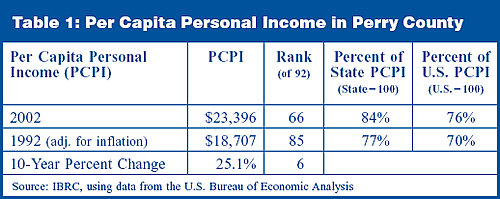
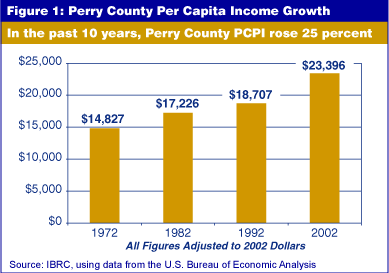
What does this mean? It shows that the income of Perry County residents is growing, providing greater wealth in the county to purchase goods and services, contribute to good causes, partake in entertainment and generally enjoy a better quality of life. In a nutshell, that is the goal of economic development.
Wages Grow by $6,500
The strongest indication of Perry County’s upward movement is the measure of average wages. By comparing the county’s average wage to that of the state as a whole, we find:
- Steady upward gains of nearly 15 points between 1993 and 2003.
- A $6,500 increase in average wage over the 10-year period.
- The 37th highest average wage in the state in 2003, compared to 78th in 1993.
In economic terms, these gains are providing more money in the wallets of people likely to spend money in the county, whether they live and work in Perry or just commute there for work. This means more money to spend on lunch, gasoline and sundries at retail stores. It also means greater financial resources for residents to buy a house or a car, thus driving more money into the Perry County economy.
Compensation
Workers in Perry County received over $243.6 million in compensation during 2003. Average compensation per job was $36,851—an increase of 13 percent from 2001 figures. During that time frame, employer contributions to pension and insurance funds grew by 44 percent.
Job Creation
Since 2001, 345 new jobs have been created in Perry County each quarter, according to recent data from the U.S. Census Bureau and the Indiana Department of Workforce Development (see Figure 2 and Table 2). While gains have been offset in more recent quarters by a growing number of job separations (particularly during the recession), this leaves a net average of 60 new jobs each quarter. There were also more than 700 new hires in the county and a turnover rate of 9 percent, which is lower than the state average of 10 percent.
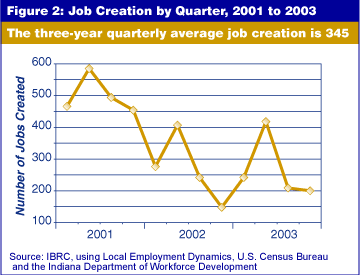
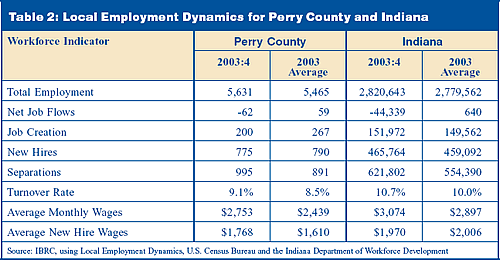
Manufacturing
Manufacturing is a major contributor to Perry County’s economy. It ranks 29th in the state in average wage per manufacturing job and in the top 600 (out of 3,141) counties nationwide.
Commuting to Perry
Based on the 2003 commuting information, just over 1,100 workers commute into Perry County for work from the four surrounding counties and Kentucky (see Figure 3). The total number commuting into Perry County exceeds 1,200. However, more than 3,000 Perry County residents leave the county to work in surrounding counties. The number of Perry County residents commuting to other counties has declined significantly though from previous years. In 2001, for example, more than 1,000 residents commuted to Kentucky for work, a number that now stands at 895.
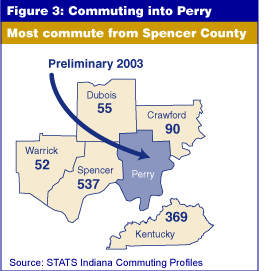
Economic Development Works, But Takes Time
Greg Wathen, executive director of the Perry County Development Corporation, believes his county can become great and told his board that in March: “We possess the ability to become a great community, not just a good one.”
Pointing to the 30 years it took for Wal-Mart to explode into the world’s largest corporation, however, he pointed out, “Becoming great doesn’t take place overnight.”(1) Six new companies have located in the county in the past 10 years, generating investment of more than $300 million and employing more than 1,000 workers. The county’s newest company is Webb Wheel Products, the most technologically advanced manufacturer in the county with equipment that does not currently exist in other North American companies (see Table 3).
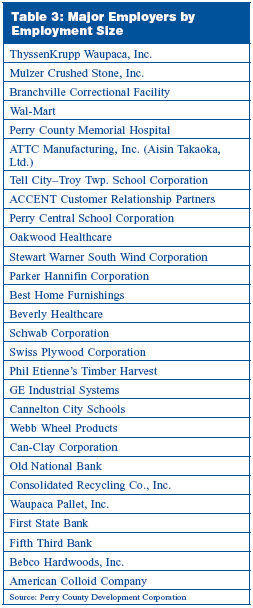
Demographics
Perry County’s population is not showing signs of growth. The most recent estimate of 18,717 is a few dozen less than what was counted in the 2000 census. The percentage loss of 1.1 percent is not significant enough to say more than that the county population has been relatively stable over time. Figure 4 shows Perry County’s population peers within the United States, as well as counties with similar wages.
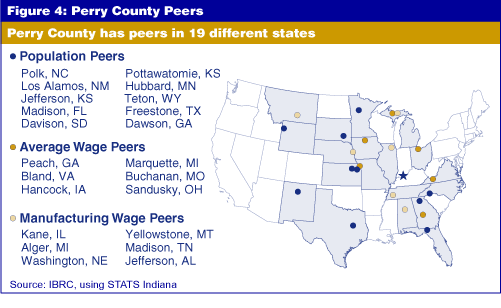
While the county’s population losses are not large, the downward trend is not necessarily one that the county wants to see. What is causing this lack of positive population growth? Perry County has a net decrease in migration, meaning more people have moved out than have moved in. It is also one of the few counties in the state with a natural decrease in population—that is, more deaths than births.
When considering the large number of family households without children and the significant number of people living alone, one can see that for now, births are not going to turn around soon without young families moving into the county. However, with the significant growth in jobs, wages and income in the county over the past several years, it seems more likely that people may begin to move into the county to be closer to those jobs.
What makes people move? Good housing at affordable prices, good schools, access to retail and services, and good infrastructure are the most cited attractions. Does Perry County have those attractions to combine with the jobs it has to offer? Space and time prevent us from considering those issues in this article. However, there is someone in Perry County who can: Greg Wathen, an award-winning and nationally recognized economic development professional who many would say has had a significant role in pushing Perry County’s job growth and wage gains. For more information, visit the Perry County Development Corporation at www.pickperry.com/.
Notes
- Kevin Koelling, “Perry County’s Economic Engine Still Revving,” Perry County News, 5 March 2005; available online at the Indiana Economic Digest: www.indianaeconomicdigest.net.
Carol O. Rogers
Associate Director, Indiana Business Research Center,
Kelley School of Business, Indiana University
